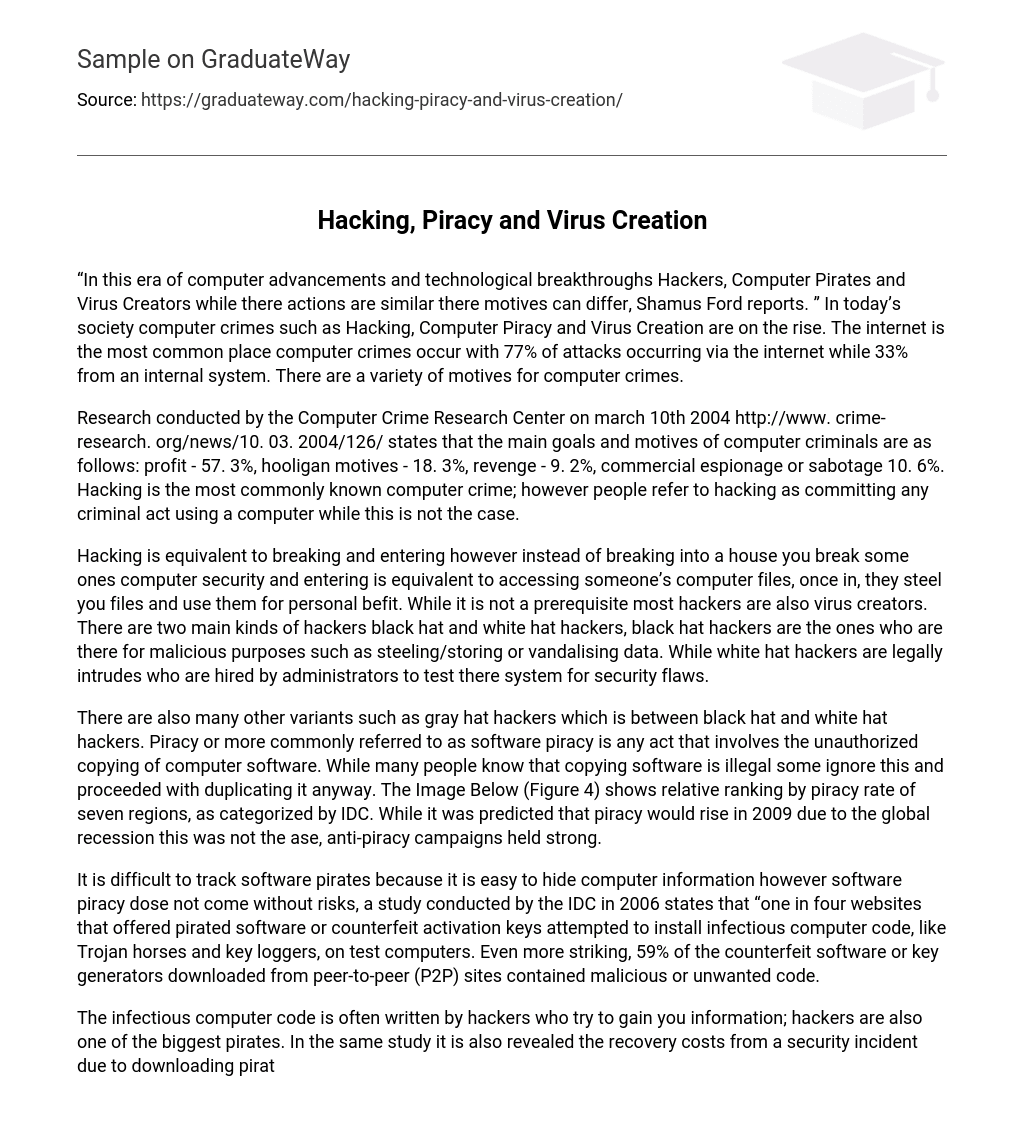Shamus Ford’s report suggests that in the current era of computer advancements and technological breakthroughs, hackers, computer pirates, and virus creators engage in similar actions but may have different motives. The prevalence of computer crimes such as hacking, computer piracy, and virus creation is on the rise in today’s society. These crimes primarily occur online with 77% of attacks happening on the internet compared to 33% internally. There exist various motivations behind these computer crimes.
Research conducted by the Computer Crime Research Center on March 10th, 2004 reveals that computer criminals have various motives. The main goals identified were profit (57.3%), hooligan motives (18.3%), revenge (9.2%), and commercial espionage or sabotage (10.6%). It is crucial to understand that not all criminal acts carried out using a computer should be classified as hacking.
Hacking can be likened to breaking and entering, except it occurs in the digital realm by compromising computer security. Instead of physically trespassing into a house, hackers infiltrate someone’s computer files to steal them for personal benefit. Additionally, many hackers develop viruses, although not always. Hackers fall into two main groups: black hat and white hat hackers. Black hat hackers engage in malicious activities such as theft, storage, or destruction of data. Conversely, white hat hackers are authorized professionals employed by administrators to assess system security for potential weaknesses.
There are various variants in hacking such as gray hat hackers, who fall between black hat and white hat hackers. Software piracy, also known as piracy, is the unauthorized act of copying computer software. Although it is widely known to be illegal, some individuals disregard this and continue to duplicate software. Figure 4 below presents the relative ranking of seven regions based on their piracy rates, as categorized by IDC. Despite the expectation that piracy would increase in 2009 due to the global recession, anti-piracy campaigns remained effective.
Tracking software pirates is challenging due to the ease of hiding computer information. However, software piracy is not without its risks. In 2006, a study conducted by the IDC revealed that 25% of websites offering pirated software or counterfeit activation keys aimed to install infectious computer code, such as Trojan horses and keyloggers, on test computers. Even more alarming, 59% of the counterfeit software or key generators obtained from peer-to-peer (P2P) sites contained malicious or unwanted code.
Hackers frequently develop infectious computer code to acquire personal information, making them significant contributors to piracy. Research indicates that the expenses incurred in recovering from a security incident resulting from downloading pirated software can surpass $100,000, often exceeding the price of purchasing the software legally. Decreasing software piracy yields numerous advantages. As per the IDC, every $1 invested generates $3-$4 in revenue. Moreover, a 10% decrease in global piracy would result in the establishment of 491,526 job opportunities across the globe.
Virus Creation is a highly destructive form of computer crime, involving the creation of infectious and typically malicious software. Hackers often distribute their creations globally, disguising them as fully functional illegal software. Unsuspecting users who download these files unknowingly infect their systems with programs that can range from simply consuming computer memory to stealing private data. It is important to note that there are other ways in which viruses can spread, such as self-replicating over Local Area Networks (LANs) or through removable memory devices like floppy disks, CDs, or USB drives.
Computer viruses serve different purposes – some are made to demonstrate programming skills, while others, often criminals, aim to deceive and steal personal information or commit online theft. With advancing technology, computer crimes are becoming more prevalent. However, there are precautions individuals can take to protect against hacking and virus infections. These include avoiding suspicious websites and illegal software downloads, as well as maintaining an updated antivirus program and firewall.
Although these suggestions provide safeguards against viruses and hackers, they do not address the problem of software piracy. Software companies have various methods to fight piracy, including lowering product prices, introducing online validation systems, and distributing a counterfeit pirated version that alerts law enforcement about individuals who download it illegally. However, due to the immense size of the internet, it is impossible to be everywhere at once. Consequently, those who possess enough knowledge can prosper.
Bibliography
The BSA and IDC conducted several studies on software piracy, including the “Piracy Impact Study: the economic Benefits of reducing software piracy” (www.bsa.org/piracyimpact, 4/11/2010), “Software Piracy on the Internet: A Threat To Your Security” (www.bsa.org, 4/11/2010), and “Seventh Annual BSA/IDC Global Software 09 Piracy Study” (www.bsa.org, 4/11/2010). References to these studies can be found at:
- http://www.computerhope.com/vlist.htm (8/11/2010)
- http://ecommerce.hostip.info (26/10/2010)
- http://www.thocp.net/reference/hacking/hacking.htm (27/10/2010)
- http://www.crime-research.org/news/10.03.2004/126/(27 /10 /2 010 )
- http :// www . brighthub . com/internet/security-privacy/articles /8647.aspx ( 27 /1 0 /2 01 0)





